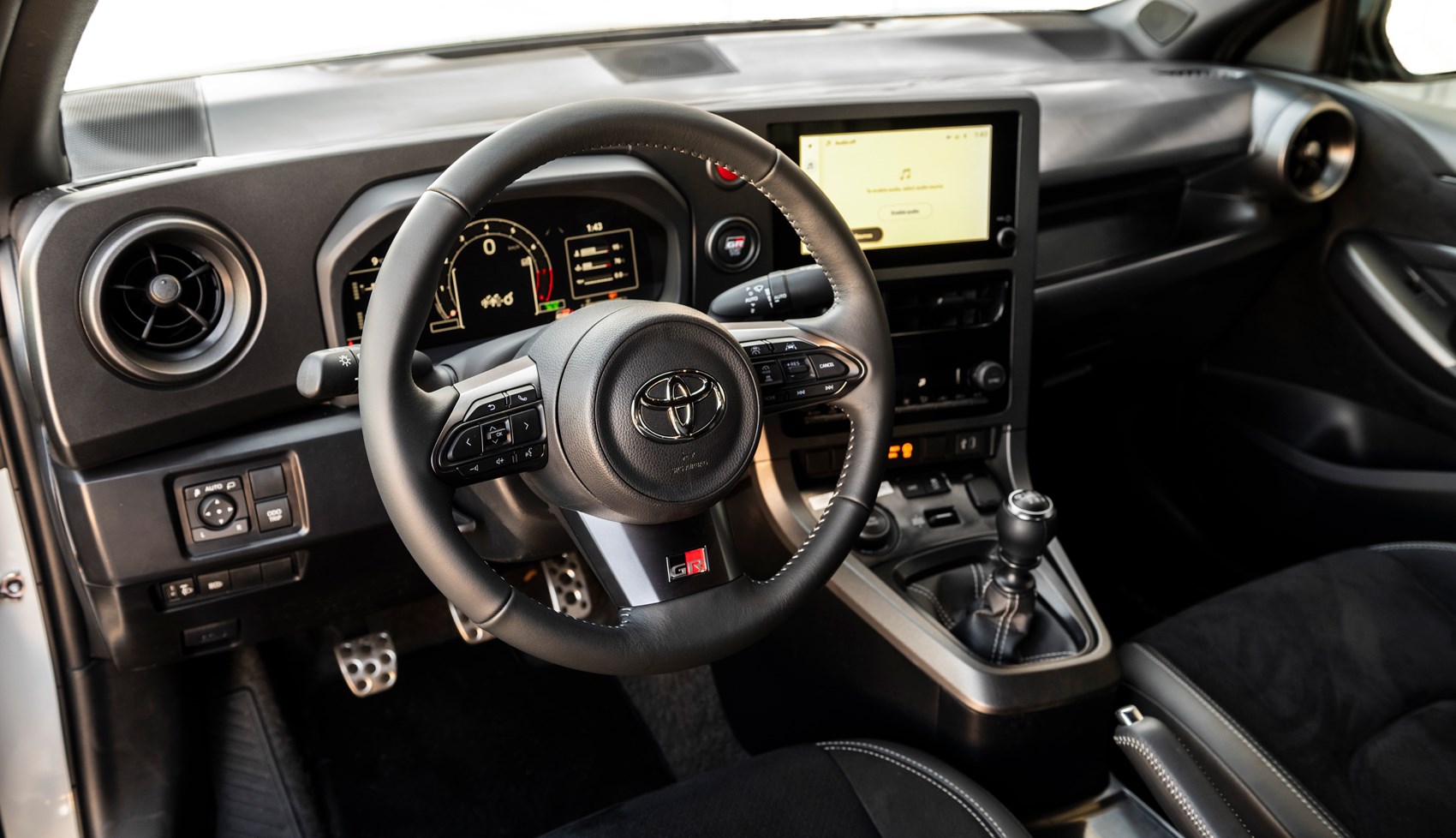► CAR tests the updated GR Yaris
► Circuit Pack standard; more upgrades besides
► Driven on track in prototype form
CAR’s wish list for an updated Toyota GR Yaris wasn’t particularly large, and yet Toyota has gone over its hot hatch with a fine-toothed comb.
We’re at Jarama race circuit in Madrid, where Toyota gleefully displays components destroyed in the heat of competition and testing – ‘develop, race, break, fix’ runs its philosophy – as well as a bumper damaged the previous day. Time to investigate those changes…
So, what has been updated?
As it turns out, quite a lot. One thing not on the wish list is a torque-converter eight-speed automatic, but that’s what we’re being offered from this summer. Thankfully a manual gearbox remains available for a much improved car that goes beyond the usual facelift box ticking. Reasons to trade up include enhanced performance, tweaked suspension, a more rigid bodyshell and a new variable torque split for the all-wheel drive. The popular Circuit Pack (Michelin Pilot 4S on BBS alloys, uprated suspension, Torsen diffs front and rear) is now standard, as is the previous Japanese-market cooling pack with its driver-controlled intercooler spray.

Arguably the biggest Yaris flaw has been tackled too, with a seating position some 25mm lower than the zen levitation of the original, while an entirely new dashboard layout similarly sits lower, introduces a new 12.3-inch digital instrument binnacle and places key controls within easier reach of the driver – a curved architecture modelled on the Mk4 Supra’s is a big part of that, though it does look a bit budget flight sim.
Come on then – tell us how those changes work in real life…
After a few laps in the existing model, I jump straight into the new car. The GR’s three-cylinder engine always impressed with its low-down flexibility and – more unusually for a triple – enthusiasm for revs. Now it feels even stronger than the 19bhp and 22lb ft increases Toyota claims – that’s 276bhp and 288lb ft in total thanks to revised pistons, fuelling adjustments and a new exhaust with reduced back pressure. For such a compact unit, the sheer feist and bandwidth to dig into here is remarkable.
Tip the Yaris into a corner and more differences bubble to the surface – there’s extra roll support over the outside front wheel compared with the standard model (which feels highly connected on the road if a little soft for circuit use) and extra precision to steering that’s otherwise as responsive and meaningfully weighted as ever.

Several factors are feeding in here, notably 28% stiffer front springs and uprated anti-roll bar (rear springs are uprated by 10%, the rear anti-roll bar unchanged), shock towers with three bolts rather than a single fastener and extra spot welds (+13%) and adhesive material (+24%).
Combined with the more tightly stacked gear ratios and more sporting seating position, the new GR offers a more stable feeling platform under braking, inspires confidence to carry higher corner speeds and therefore keep the engine on the boil, and provides more urgent acceleration as you power past the apex. I’m surprised how much faster I arrive at Jarama’s second corner.

Select Track mode and the all-wheel drive system that previously locked with a 50/50 split in Track can now vary between 60/40 and 70/30 front to rear – it makes for a logically more rear-biased feel in mid-speed corners (though the previous Sport mode /did/ offer a fixed 30/70 split for a similar feel). Either way, it combines nicely with the GR’s throttle-adjustable handling balance.
Jarama’s tighter corners prove less satisfying, with more scrub from the front Michelin 4S tyres than I’d like and still the feeling that this short, keen-to-turn hatch is placing much of its admirably fleet 1280kg over the outside front wheel – though generous torque allows you to calm understeer with an early upshift, and the Torsen LSD integrated in the front axle of both manual and auto models is effective at pulling you from the corner. I’d definitely want stickier rubber for any track with more technical, slower-speed corners, though.
And what of that gearbox? Toyota says it chose a torque converter rather than a dual-clutch unit for durability purposes, because it has expertise in the area and the all-new ’box has been proven in the heat of domestic race and rally competition.

It’s said to add 20kg over the nose but save a second over the short lap of Fuji Speedway. Left in Drive, it also manages to give me the right gear on cue, intelligently adapting to my driving style in the process.
Switch to manual and you can either use paddles fixed to the wheel or a lever configured in the push-for-downshifts/pull-for-upshifts racecar style, but while the shifts again pop-in on demand, the shift quality is somewhat variable – when I hold it to the redline to see if it’ll auto shift (it does), the shift clicks in with real mechanical precision, but mostly the changes are a little soft and often characterised by a delayed, liquidy sort of impulse. Ultimately effective, then, but BMW and Jaguar make the trad torque convertor feel sharper.
Thankfully the shift action of the revised manual gearbox is significantly cleaner than the knuckly original, and while it’s still miles off the snickety precision of a Civic Type R and the pedal spacing could be sweeter for heel and toe, the threat of a mis-shift feels massively reduced.
Toyota GR Yaris facelift: first impressions
This is a classic case of numerous small details adding up to be greater than the sum of their parts. The GR Yaris has a much-improved seating position, dash and infotainment, while it’s powertrain and handling make it feel more urgent and better balanced than before. While effective, we’d pass on the auto, especially given the manual shift is much better. The big question now is how this stiffer chassis translates to UK roads, something we’ll discover soon enough.